The Spatiotemporal Variability of Ozone and Nitrogen Dioxide in the Po Valley Using In Situ Measurements and Model Simulations
Abstract
1. Introduction
2. Materials and Methods
2.1. Area of the Po Valley
2.2. European Environment Agency Air Quality Monitoring
2.3. LOTOS-EUROS Chemical Transport Modeling System
2.4. Methodology
3. Results
3.1. Surface Air Quality Assessment
3.1.1. Monthly Mean Comparisons
3.1.2. Seasonal and Diurnal Comparisons
3.1.3. Co-Variability of Ozone and Nitrogen Dioxide Levels
4. Discussion
5. Conclusions
- LOTOS-EUROS CTM simulations showed a strong correlation with EEA measurements (R > 0.98) on a monthly mean basis and displayed R values between 0.83 and 0.98 on a seasonal diurnal temporal scale, indicating that the LOTOS-EUROS model is highly effective at capturing the spatiotemporal temporal patterns and overall seasonal trends of ozone concentrations.
- The inverse correlation between ozone and nitrogen dioxide surface levels reported by the EEA in situ measurements reports high R values from −0.76 to −0.88, while the CTM, due to the spatial resolution of the simulations which prevents the identification of local effects, reports higher correlations of −0.96 to −0.99.
- The consistent overestimation of ozone concentrations during their morning peak levels in January and February 2022 identified in this work remains a point for further investigation.
Author Contributions
Funding
Data Availability Statement
Acknowledgments
Conflicts of Interest
Appendix A
| Sampling Point | Name/Locality | City | Station Type |
|---|---|---|---|
| SPO.IT0705A | Verziere | Milano | Traffic urban |
| SPO.IT0706A | Via Palermo Angolo | Pioltello | Background urban |
| SPO.IT0804A | Parco Cittadella | Parma | Background urban |
| SPO.IT0842A | V. villa | Cremona | Industrial rural |
| SPO.IT0892A | Giardini Margherita | Bologna | Background urban |
| SPO.IT0912A | Via Folperti | Pavia | Background urban |
| SPO.IT0940A | Via Amendola | Reggio N. Emilia | Background urban |
| SPO.IT1144A | Via Pilalunga | Savona | Industrial suburban |
| SPO.IT1459A | Accam | Busto Arsizio | Background suburban |
| SPO.IT1590A | Lancieridi Novara | Treviso | Background urban |
| SPO.IT1650A | Santuario | Saronno | Background urban |
| SPO.IT1692A | Pascal | Milan | Background urban |
| SPO.IT1737A | Vilaggio Sereno | Brescia | Background urban |
| SPO.IT1739A | Fatebene fratelli | Cremona | Background urban |
| SPO.IT1743A | Machiavelli | Monza | Background urban |
| SPO.IT1746A | Via Vigne | Pavia | Industrial rural |
| SPO.IT1771A | Parco Ferrari | Modena | Background urban |
| SPO.IT1830A | Spalto Marengo | Alessandria | Background urban |
| SPO.IT1871A | Via Bragadine | Este | Industrial suburban |
| SPO.IT1877A | Rubino | Torino | Background urban |
| SPO.IT1918A | Villa Fulvia | Ferrara | Background urban |
| SPO.IT1975A | Parco Montecucco | Piacenza | Background urban |
| SPO.IT2063A | Via Cesare Battisti | Cremona | Industrial rural |
| SPO.IT2075A | Chiarini | Bologna | Background suburban |
| SPO.IT2098A | Mirabellino | Monza | Background suburban |
| SPO.IT2168A | Viale Augusto Monti | Torino | Background urban |
| SPO.IT2232A | Edison | Cormano | Background urban |
| SPO.IT2282A | Arpa | Novara | Background urban |
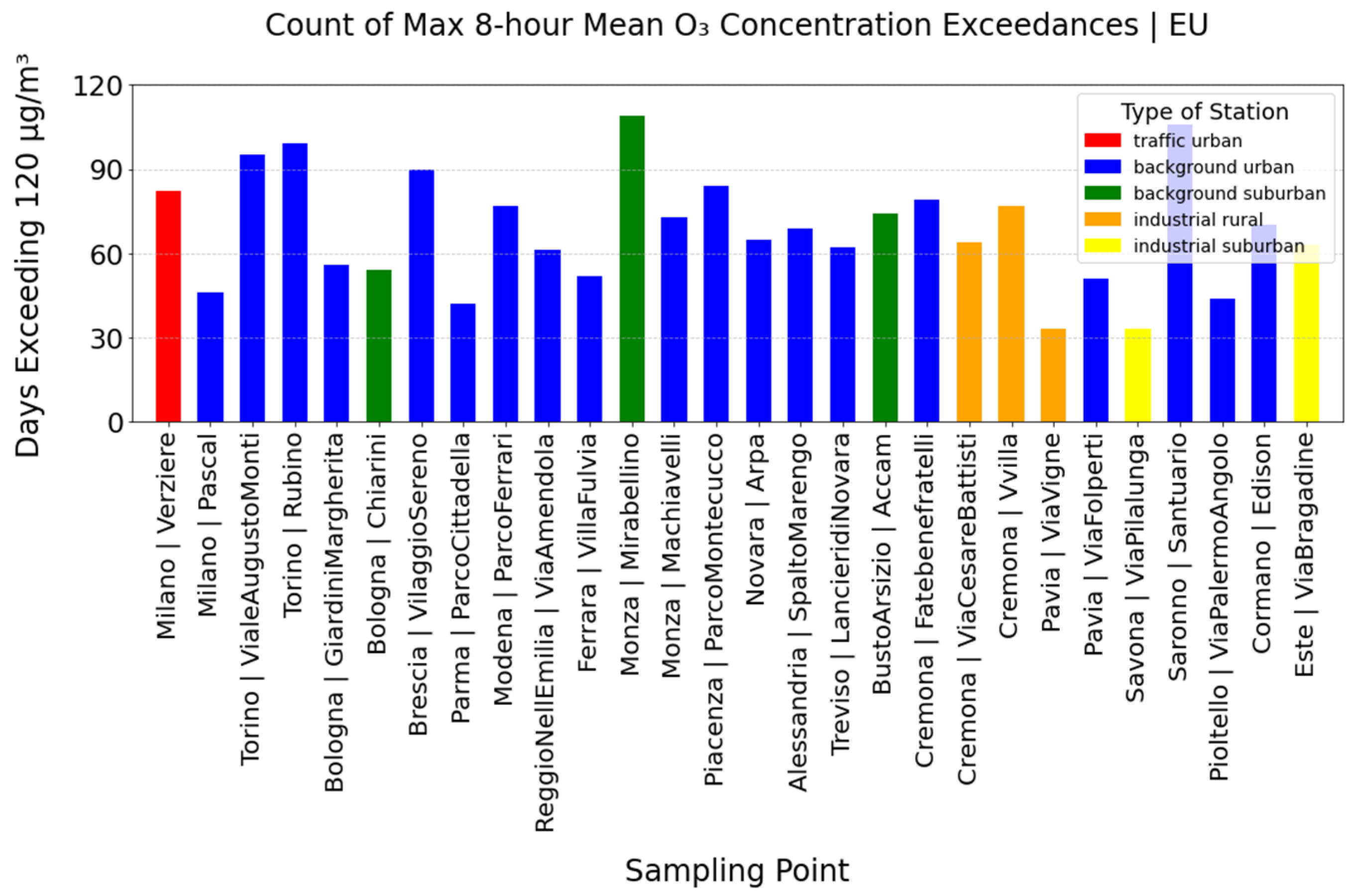
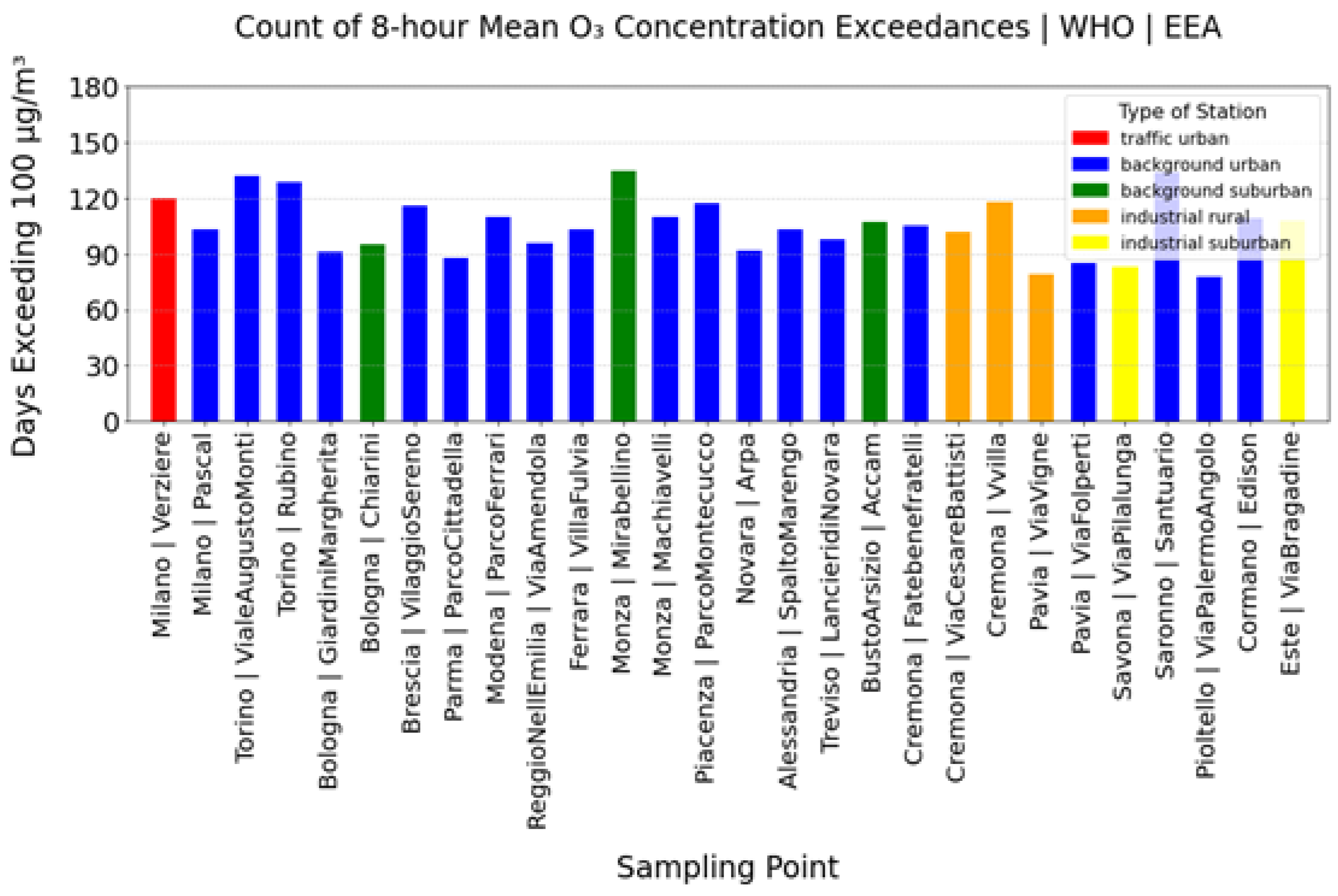
References
- Sharma, A.K.; Sharma, M.; Sharma, A.K.; Sharma, M.; Sharma, M. Mapping the impact of environmental pollutants on human health and environment: A systematic review and meta-analysis. J. Geochem. Explor. 2023, 255, 107325. [Google Scholar] [CrossRef]
- Husain, L.; Coffey, P.E.; Meyers, R.E.; Cederwall, R.T. Ozone transport from stratosphere to troposphere. Geophys. Res. Lett. 1977, 4, 363–365. [Google Scholar] [CrossRef]
- Stohl, A.; Trickl, T. Long-Range Transport of Ozone from the North American Boundary Layer to Europe: Observations and Model Results. In Air Pollution Modeling and Its Application XIV; Springer: Boston, MA, USA, 2006; pp. 257–266. [Google Scholar] [CrossRef]
- Crutzen, P.J. The Role of NO and NO2 in the Chemistry of the Troposphere and Stratosphere. Annu. Rev. Earth Planet. Sci. 1979, 7, 443–472. [Google Scholar] [CrossRef]
- Jiang, X.; Cheng, X.; Liu, J.; Chen, Z.; Wang, H.; Deng, H.; Hu, J.; Jiang, Y.; Yang, M.; Gai, C.; et al. Comparison of Surface Ozone Variability in Mountainous Forest Areas and Lowland Urban Areas in Southeast China. Atmosphere 2024, 15, 519. [Google Scholar] [CrossRef]
- Lakshmi, K.A.K.; Nishanth, T.; Kumar, S.; Valsaraj, K.T. A Comprehensive Review of Surface Ozone Variations in Several Indian Hotspots. Atmosphere 2024, 15, 852. [Google Scholar] [CrossRef]
- Badr, O.; Probert, S.D. Oxides of nitrogen in the Earth’s atmosphere: Trends, sources, sinks and environmental impacts. Appl. Energy 1993, 46, 1–67. [Google Scholar] [CrossRef]
- Monks, P.S.; Archibald, A.T.; Colette, A.; Cooper, O.; Coyle, M.; Derwent, R.; Fowler, D.; Granier, C.; Law, K.S.; Mills, G.E.; et al. Tropospheric ozone and its precursors from the urban to the global scale from air quality to short-lived climate forcer. Atmos. Chem. Phys. 2015, 15, 8889–8973. [Google Scholar] [CrossRef]
- Koukouli, M.-E.; Pseftogkas, A.; Karagkiozidis, D.; Skoulidou, I.; Drosoglou, T.; Balis, D.; Bais, A.F.; Melas, D.; Hatzianastassiou, N. Air Quality in Two Northern Greek Cities Revealed by Their Tropospheric NO2 Levels. Atmosphere 2022, 13, 840. [Google Scholar] [CrossRef]
- Beirle, S.; Platt, U.; Wenig, M.; Wagner, T. Weekly cycle of NO2 by GOME measurements: A signature of anthropogenic sources. Atmos. Chem. Phys. 2003, 3, 2225–2232. [Google Scholar] [CrossRef]
- Jenkin, M.E.; Clemitshaw, K.C. Chapter 11 Ozone and other secondary photochemical pollutants: Chemical processes governing their formation in the planetary boundary layer. Dev. Environ. Sci. 2002, 1, 285–338. [Google Scholar] [CrossRef]
- Wayne, R.P.; Barnes, I.; Biggs, P.; Burrows, J.P.; Canosa-Mas, C.E.; Hjorth, J.; Le Bras, G.; Moortgat, G.K.; Perner, D.; Poulet, G.; et al. The nitrate radical: Physics, chemistry, and the atmosphere. Atmos. Environ. Part A. Gen. Top. 1991, 25, 1–203. [Google Scholar] [CrossRef]
- Atkinson, R.; Arey, J. Gas-phase tropospheric chemistry of biogenic volatile organic compounds: A review. Atmos. Environ. 2003, 37, 197–219. [Google Scholar] [CrossRef]
- Stull, R.B. An Introduction to Boundary Layer Meteorology; Springer: New York, NY, USA, 2012. [Google Scholar]
- Jacob, D.J. Introduction to Atmospheric Chemistry; Princeton University Press: Princeton, NJ, USA, 1999. [Google Scholar]
- Po Valley. Available online: https://geography.name/po-valley/ (accessed on 10 May 2025).
- Pivato, A.; Pegoraro, L.; Masiol, M.; Bortolazzo, E.; Bonato, T.; Formenton, G.; Cappai, G.; Beggio, G.; Giancristofaro, R.A. Long time series analysis of air quality data in the Veneto region (Northern Italy) to support environmental policies. Atmos. Environ. 2023, 298, 119610. [Google Scholar] [CrossRef]
- Masiol, M.; Squizzato, S.; Formenton, G.; Harrison, R.M.; Agostinelli, C. Air quality across a European hotspot: Spatial gradients, seasonality, diurnal cycles and trends in the Veneto region, NE Italy. Sci. Total Environ. 2017, 576, 210–224. [Google Scholar] [CrossRef]
- European Commission. Air Quality. Available online: https://environment.ec.europa.eu/topics/air/air-quality_en (accessed on 10 May 2025).
- World Health Organization. What Are the WHO Air Quality Guidelines? 2021. Available online: https://www.who.int/news-room/feature-stories/detail/what-are-the-who-air-quality-guidelines (accessed on 10 May 2025).
- Benassi, A.; Dalan, F.; Gnocchi, A.; Maffeis, G.; Malvasi, G.; Liguori, F.; Pernigotti, D.; Pillon, S.; Sansone, M.; Susanetti, L. A one-year application of the Veneto air quality modelling system: Regional concentrations and deposition on Venice lagoon. Int. J. Environ. Pollut. 2011, 44, 32. [Google Scholar] [CrossRef]
- Martilli, A.; Neftel, A.; Favaro, G.; Kirchner, F.; Sillman, S.; Clappier, A. Simulation of the ozone formation in the northern part of the Po Valley. J. Geophys. Res. 2002, 107, 8195. [Google Scholar] [CrossRef]
- Maurizi, A.; Russo, F.; Tampieri, F. Local vs. external contribution to the budget of pollutants in the Po Valley (Italy) hot spot. Sci. Total Environ. 2013, 458–460, 459–465. [Google Scholar] [CrossRef]
- Bigi, A.; Ghermandi, G.; Harrison, R.M. Analysis of the air pollution climate at a background site in the Po valley. J. Environ. Monit. 2012, 14, 552–563. [Google Scholar] [CrossRef]
- Spirig, C.; Neftel, A.; Kleinman, L.I.; Hjorth, J. NOx versus VOC limitation of O3 production in the Po valley: Local and integrated view based on observations. J. Geophys. Res. 2002, 107, 8191. [Google Scholar] [CrossRef]
- Kaiser, J.; Wolfe, G.M.; Bohn, B.; Broch, S.; Fuchs, H.; Ganzeveld, L.N.; Gomm, S.; Häseler, R.; Hofzumahaus, A.; Holland, F.; et al. Evidence for an unidentified non-photochemical ground-level source of formaldehyde in the Po Valley with potential implications for ozone production. Atmos. Chem. Phys. 2015, 15, 1289–1298. [Google Scholar] [CrossRef]
- Thunis, P.; Triacchini, G.; White, L.; Maffeis, G.; Volta, M. Air Pollution and Emission Reductions over the Po-Valley: Air Quality Modelling and Integrated Assessment. 18th World IMACS/MODSIM. 2009. Available online: https://mssanz.org.au/modsim09/F10/thunis.pdf (accessed on 15 December 2024).
- Cai, M.; Ye, C.; Yuan, B.; Huang, S.; Zheng, E.; Yang, S.; Wang, Z.; Lin, Y.; Li, T.; Hu, W.; et al. Enhanced daytime secondary aerosol formation driven by gas–particle partitioning in downwind urban plumes. Atmos. Chem. Phys. 2024, 24, 13065–13079. [Google Scholar] [CrossRef]
- Zhang, G.; Yu, X.; Yin, H.; Feng, C.; Ma, C.; Sun, S.; Cheng, H.; Wang, S.; Shang, K.; Liu, X. Heatwave-amplified atmospheric oxidation in a multi-province border area in Xuzhou, China. Front. Environ. Sci. 2024, 12. [Google Scholar] [CrossRef]
- Manders, A.M.M.; Builtjes, P.J.H.; Curier, L.; van der Gon, H.A.C.D.; Hendriks, C.; Jonkers, S.; Kranenburg, R.; Kuenen, J.J.P.; Segers, A.J.; Timmermans, R.M.A. Curriculum vitae of the LOTOS–EUROS (v2.0) chemistry transport model. Geosci. Model Dev. 2017, 10, 4145–4173. [Google Scholar] [CrossRef]
- Topographic Maps. Po Valley Topographic Map, Elevation, Terrain. Available online: https://en-us.topographic-map.com/map-6ffntf/Po-Valley/ (accessed on 15 December 2024).
- Zhu, T.; Melamed, M.L.; Parrish, D.; Gllardo Klenner, L.; Lawrence, M.; Konare, A.; Liousse, C. (Eds.) WMO/IGAC Impacts of Megacities on Air Pollution and Climate; World Meteorological Organization: Geneva, Switzerland, 2012; 299p, ISBN 978-0-9882867-0-2. [Google Scholar]
- Hakim, Z.M.; Archer-Nicholls, S.; Beig, G.; Folberth, G.A.; Sudo, K.; Abraham, N.L.; Ghude, S.D.; Henze, D.K.; Archibald, A.T. Evaluation of tropospheric ozone and ozone precursors in simulations from the HTAPII and CCMI model intercomparisons—A focus on the Indian subcontinent. Atmos. Chem. Phys. 2019, 19, 6437–6458. [Google Scholar] [CrossRef]
- Caserini, S.; Giani, P.; Cacciamani, C.; Ozgen, S.; Lonati, G. Influence of climate change on the frequency of daytime temperature inversions and stagnation events in the Po Valley: Historical trend and future projections. Atmos. Res. 2017, 184, 15–23. [Google Scholar] [CrossRef]
- Masiol, M.; Agostinelli, C.; Formenton, G.; Tarabotti, E.; Pavoni, B. Thirteen years of air pollution hourly monitoring in a large city: Potential sources, trends, cycles and effects of car-free days. Sci. Total Environ. 2014, 494–495, 84–96. [Google Scholar] [CrossRef]
- Bigi, A.; Ghermandi, G. Long-term trend and variability of atmospheric PM10 concentration in the Po Valley. Atmos. Chem. Phys. 2014, 14, 4895–4907. [Google Scholar] [CrossRef]
- Serio, C.; Masiello, G.; Cersosimo, A. NO2 pollution over selected cities in the Po valley in 2018–2021 and its possible effects on boosting COVID-19 deaths. Heliyon 2022, 8, e09978. [Google Scholar] [CrossRef]
- Schaap, M.; Timmermans, R.M.A.; Roemer, M.; Boersen, G.A.C.; Builtjes, P.J.H.; Sauter, F.J.; Velders, G.J.M.; Beck, J.P. The LOTOS–EUROS model: Description, validation and latest developments. Int. J. Environ. Pollut. 2008, 32, 270–290. [Google Scholar] [CrossRef]
- Skoulidou, I.; Koukouli, M.-E.; Manders, A.; Segers, A.; Karagkiozidis, D.; Gratsea, M.; Balis, D.; Bais, A.; Gerasopoulos, E.; Stavrakou, T.; et al. Evaluation of the LOTOS-EUROS NO2 simulations using ground-based measurements and S5P/TROPOMI observations over Greece. Atmos. Chem. Phys. 2021, 21, 5269–5288. [Google Scholar] [CrossRef]
- Pseftogkas, A.; Koukouli, M.-E.; Segers, A.; Manders, A.; van Geffen, J.; Balis, D.; Meleti, C.; Stavrakou, T.; Eskes, H. Comparison of S5P/TROPOMI Inferred NO2 Surface Concentrations with In Situ Measurements over Central Europe. Remote Sens. 2022, 14, 4886. [Google Scholar] [CrossRef]
- Escudero, M.; Segers, A.; Kranenburg, R.; Querol, X.; Alastuey, A.; Borge, R.; de la Paz, D.; Gangoiti, G.; Schaap, M. Analysis of summer O3 in the Madrid air basin with the LOTOS-EUROS chemical transport model. Atmos. Chem. Phys. 2019, 19, 14211–14232. [Google Scholar] [CrossRef]
- Curier, R.L.; Timmermans, R.; Calabretta-Jongen, S.; Eskes, H.; Segers, A.; Swart, D.; Schaap, M. Improving ozone forecasts over Europe by synergistic use of the LOTOS-EUROS chemical transport model and in-situ measurements. Atmos. Environ. 2012, 60, 217–226. [Google Scholar] [CrossRef]
- Hersbach, H.; Bell, B.; Berrisford, P.; Hirahara, S.; Horányi, A.; Muñoz-Sabater, J.; Nicolas, J.; Peubey, C.; Radu, R.; Schepers, D.; et al. The ERA5 global reanalysis. Q. J. R. Meteorol. Soc. 2020, 146, 1999–2049. [Google Scholar] [CrossRef]
- Kuenen, J.; Dellaert, S.; Visschedijk, A.; Jalkanen, J.-P.; Super, I.; van der Gon, H.D. CAMS-REG-v4: A state-of-the-art high-resolution European emission inventory for air quality modelling. Earth Syst. Sci. Data 2022, 14, 491–515. [Google Scholar] [CrossRef]
- van der Gon, H.D.; Gauss, M.; Granier, C.; Arellano, S.; Benedictow, A.; Darras, S.; Dellaert, S.; Guevara, M.; Jalkanen, J.-P.; Krueger, K.; et al. Copernicus Atmosphere CAMS2_61—Global and European Emission Inventories Documentation of CAMS Emission Inventory Products; Copernicus Atmosphere Monitoring Service: Reading, UK, 2023. [Google Scholar] [CrossRef]
- Lu, X.; Zhang, L.; Shen, L. Meteorology and Climate Influences on Tropospheric Ozone: A Review of Natural Sources, Chemistry, and Transport Patterns. Curr. Pollut. Rep. 2019, 5, 238–260. [Google Scholar] [CrossRef]
- Sullivan, J.T.; Apituley, A.; Mettig, N.; Kreher, K.; Knowland, K.E.; Allaart, M.; Piters, A.; Van Roozendael, M.; Veefkind, P.; Ziemke, J.R.; et al. Tropospheric and stratospheric ozone profiles during the 2019 TROpomi vaLIdation eXperiment (TROLIX-19). Atmos. Chem. Phys. 2022, 22, 11137–11153. [Google Scholar] [CrossRef]
- Nguyen, D.-H.; Lin, C.; Vu, C.-T.; Cheruiyot, N.K.; Nguyen, M.K.; Le, T.H.; Lukkhasorn, W.; Vo, T.-D.-H.; Bui, X.-T. Tropospheric ozone and NOx: A review of worldwide variation and meteorological influences. Environ. Technol. Innov. 2022, 28, 102809. [Google Scholar] [CrossRef]
- Wang, X.; Zhou, L.; Liu, Y.; Zhang, K.; Xiu, G. Investigating the photolysis of NO2 and influencing factors by using a DFT/TD-DFT method. Atmos. Environ. 2020, 230, 117559. [Google Scholar] [CrossRef]
- Jia, M.; Zhao, T.; Cheng, X.; Gong, S.; Zhang, X.; Tang, L.; Liu, D.; Wu, X.; Wang, L.; Chen, Y. Inverse Relations of PM2.5 and O3 in Air Compound Pollution between Cold and Hot Seasons over an Urban Area of East China. Atmosphere 2017, 8, 59. [Google Scholar] [CrossRef]
- Mar, K.A.; Ojha, N.; Pozzer, A.; Butler, T.M. Ozone air quality simulations with WRF-Chem (v3.5.1) over Europe: Model evaluation and chemical mechanism comparison. Geosci. Model Dev. 2016, 9, 3699–3728. [Google Scholar] [CrossRef]
- Adam-Poupart, A.; Brand, A.; Fournier, M.; Jerrett, M.; Smargiassi, A. Spatiotemporal Modeling of Ozone Levels in Quebec (Canada): A Comparison of Kriging, Land-Use Regression (LUR), and Combined Bayesian Maximum Entropy–LUR Approaches. Environ. Health Perspect. 2014, 122, 970–976. [Google Scholar] [CrossRef] [PubMed]
- Katragkou, E.; Zanis, P.; Tsikerdekis, A.; Kapsomenakis, J.; Melas, D.; Eskes, H.; Flemming, J.; Huijnen, V.; Inness, A.; Schultz, M.G.; et al. Evaluation of near-surface ozone over Europe from the MACC reanalysis. Geosci. Model Dev. 2015, 8, 2299–2314. [Google Scholar] [CrossRef]
- Buteau, S.; Hatzopoulou, M.; Crouse, D.L.; Smargiassi, A.; Burnett, R.T.; Logan, T.; Cavellin, L.D.; Goldberg, M.S. Comparison of spatiotemporal prediction models of daily exposure of individuals to ambient nitrogen dioxide and ozone in Montreal, Canada. Environ. Res. 2017, 156, 201–230. [Google Scholar] [CrossRef]
- Valari, M.; Menut, L. Does an Increase in Air Quality Models’ Resolution Bring Surface Ozone Concentrations Closer to Reality? J. Atmos. Ocean. Technol. 2008, 25, 1955–1968. [Google Scholar] [CrossRef]


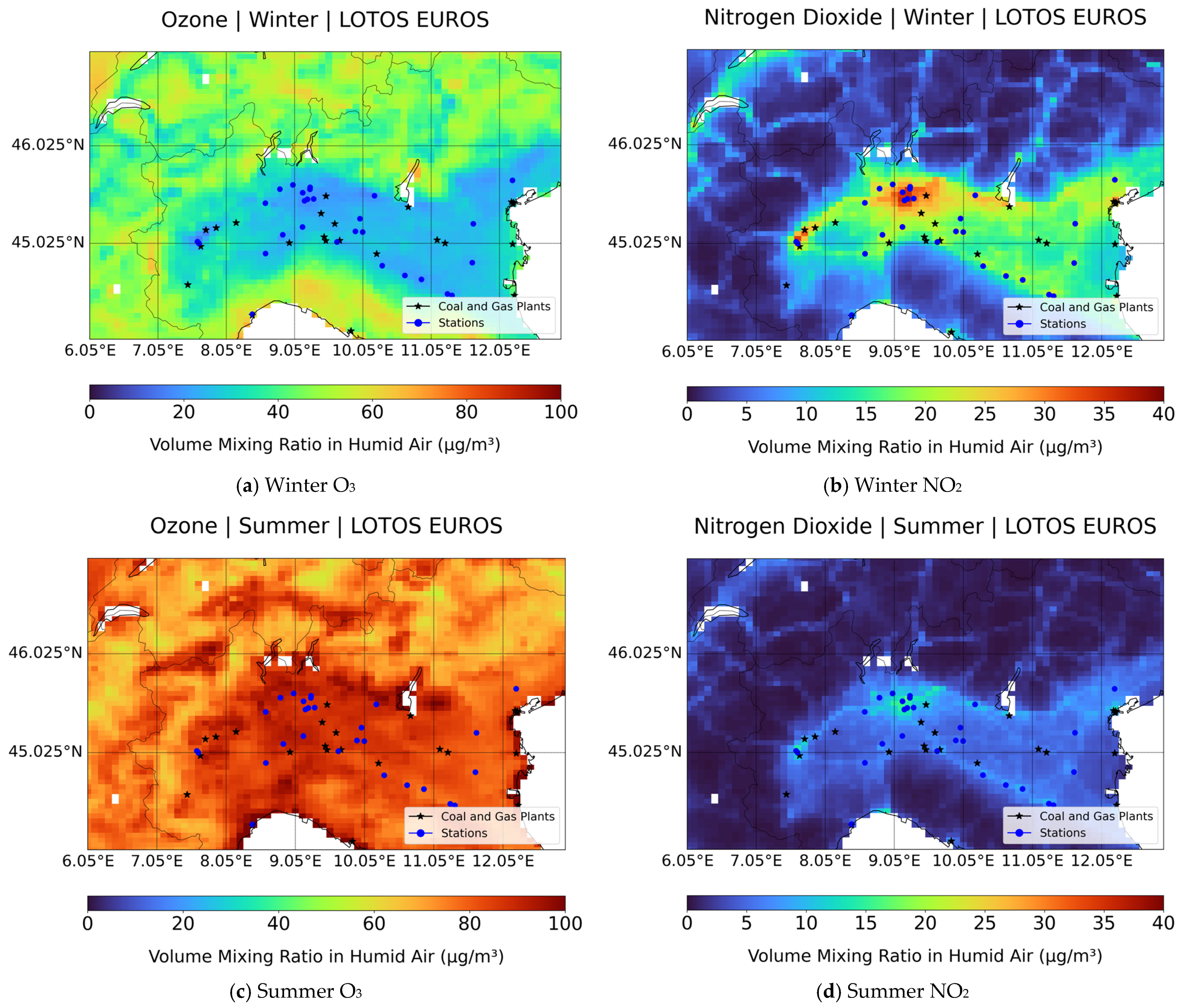
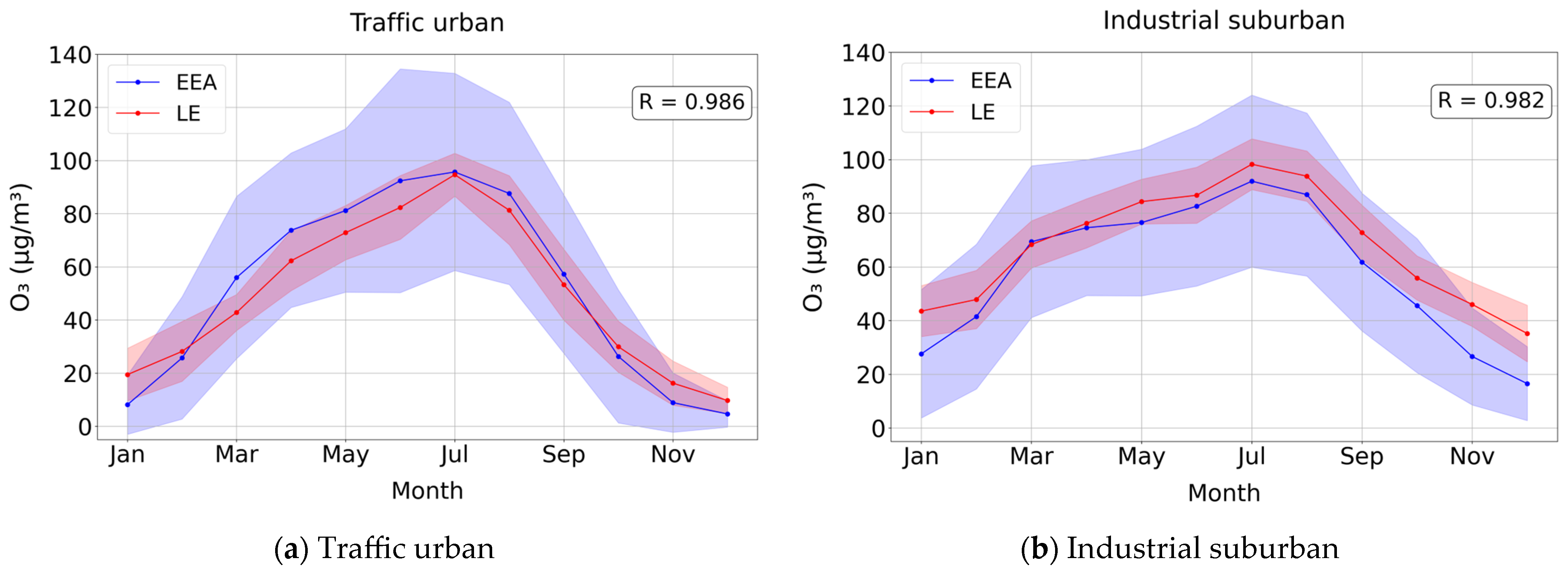
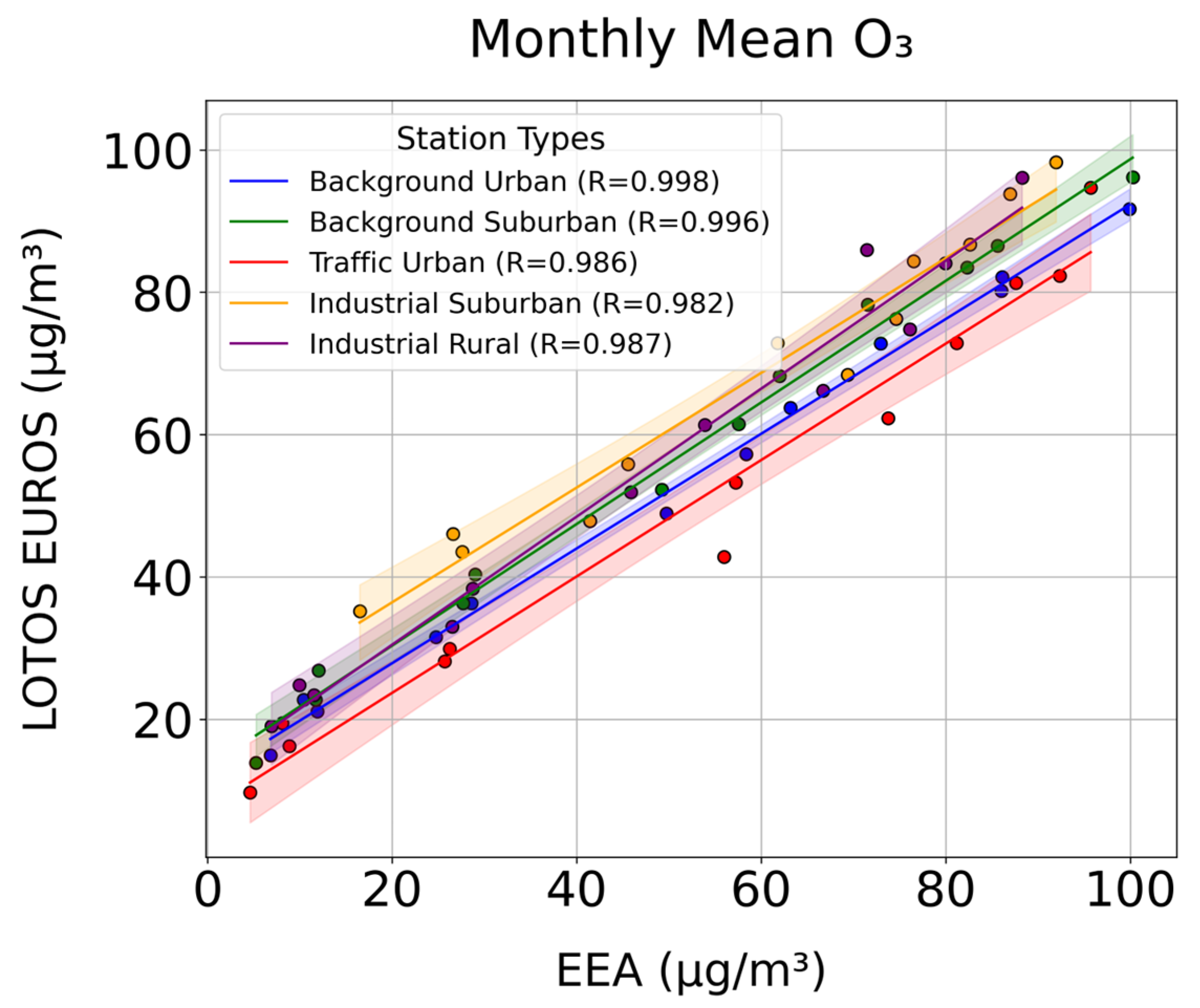

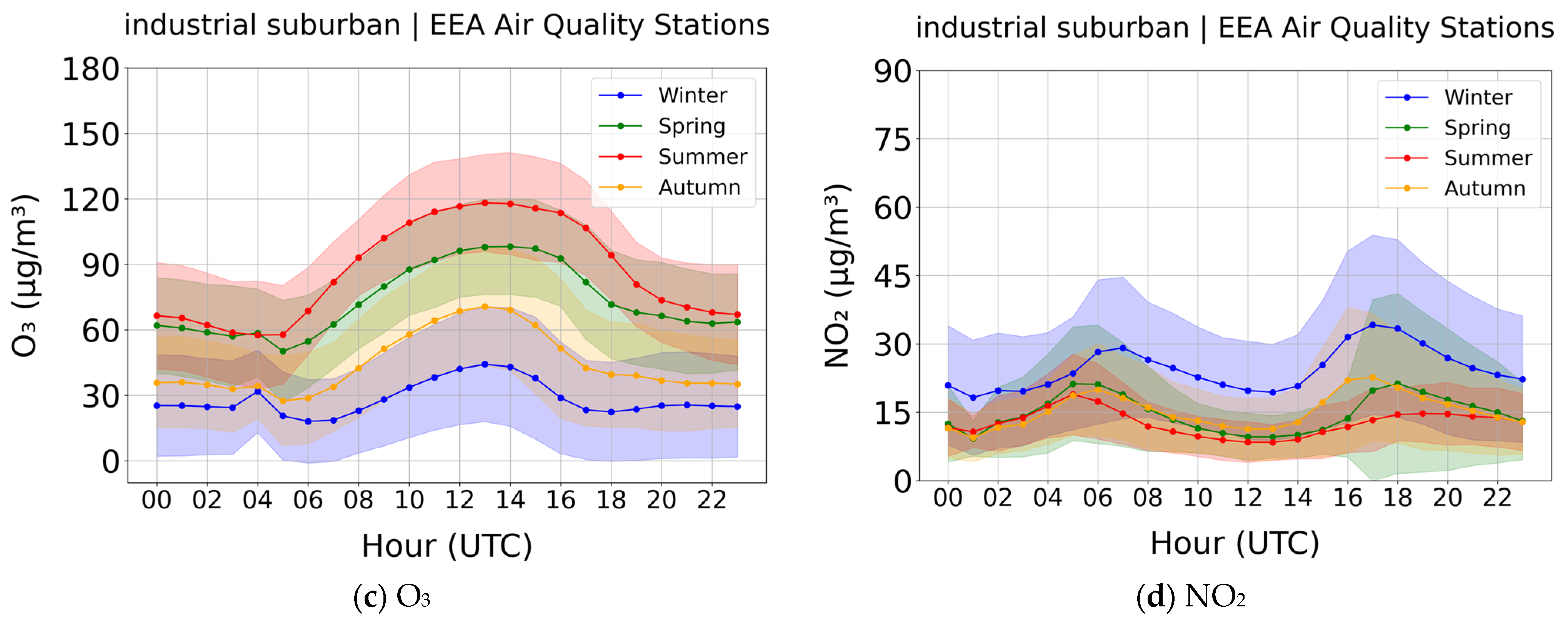
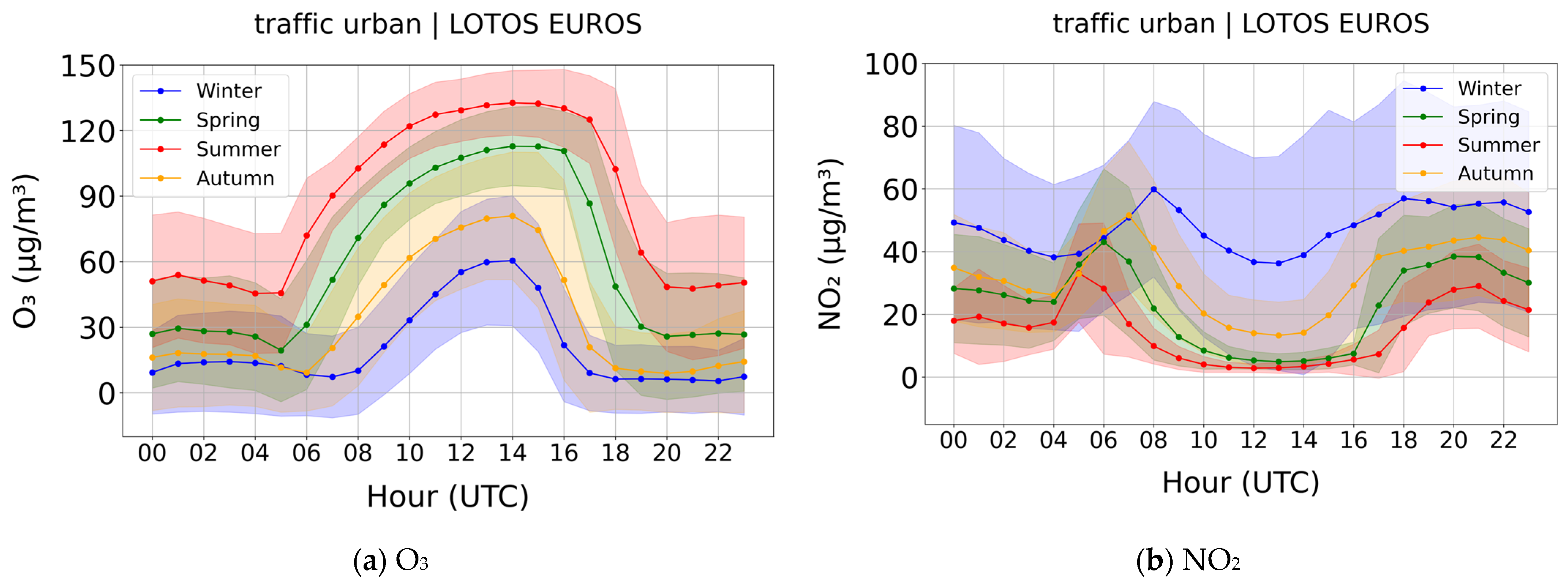

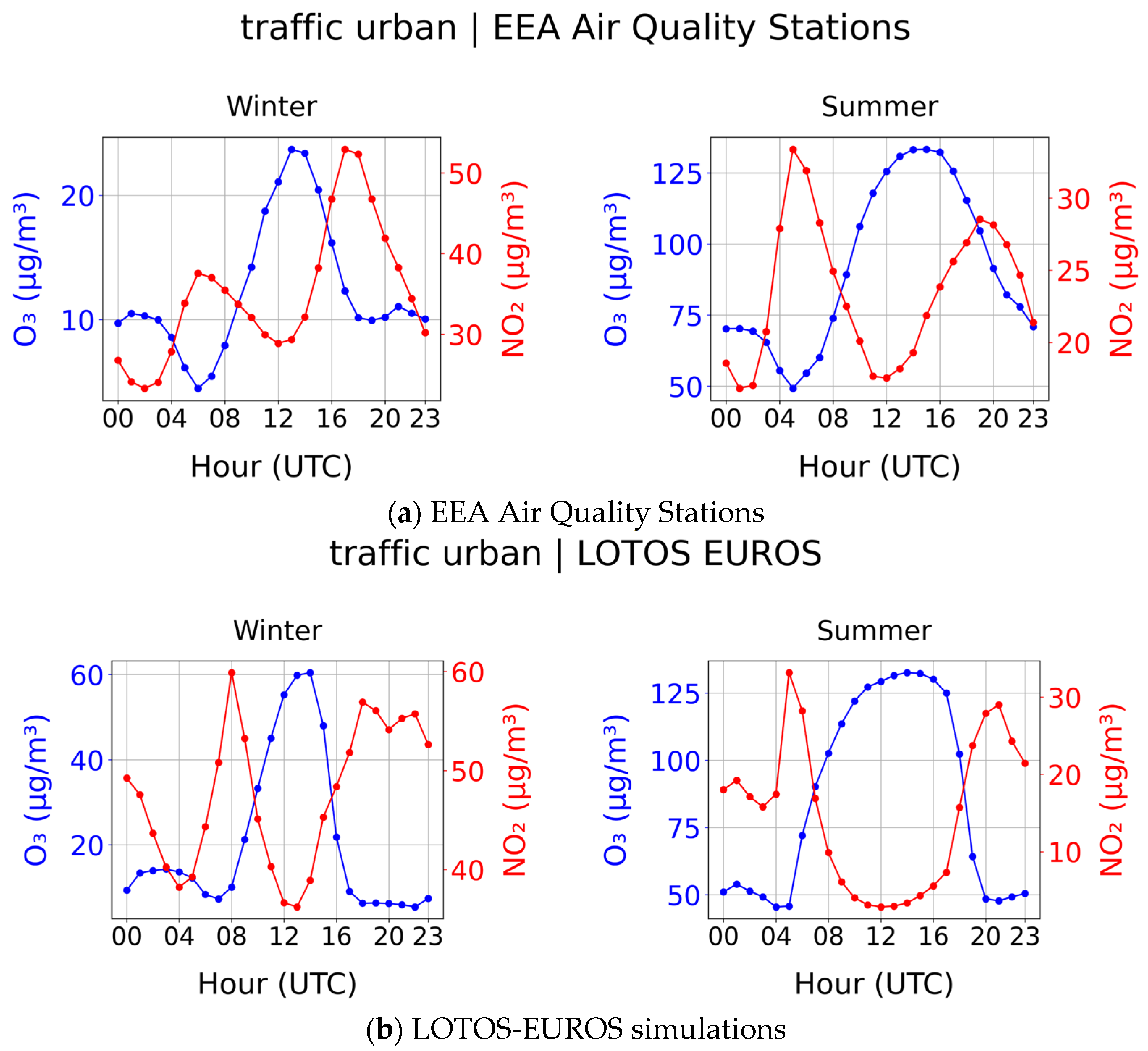
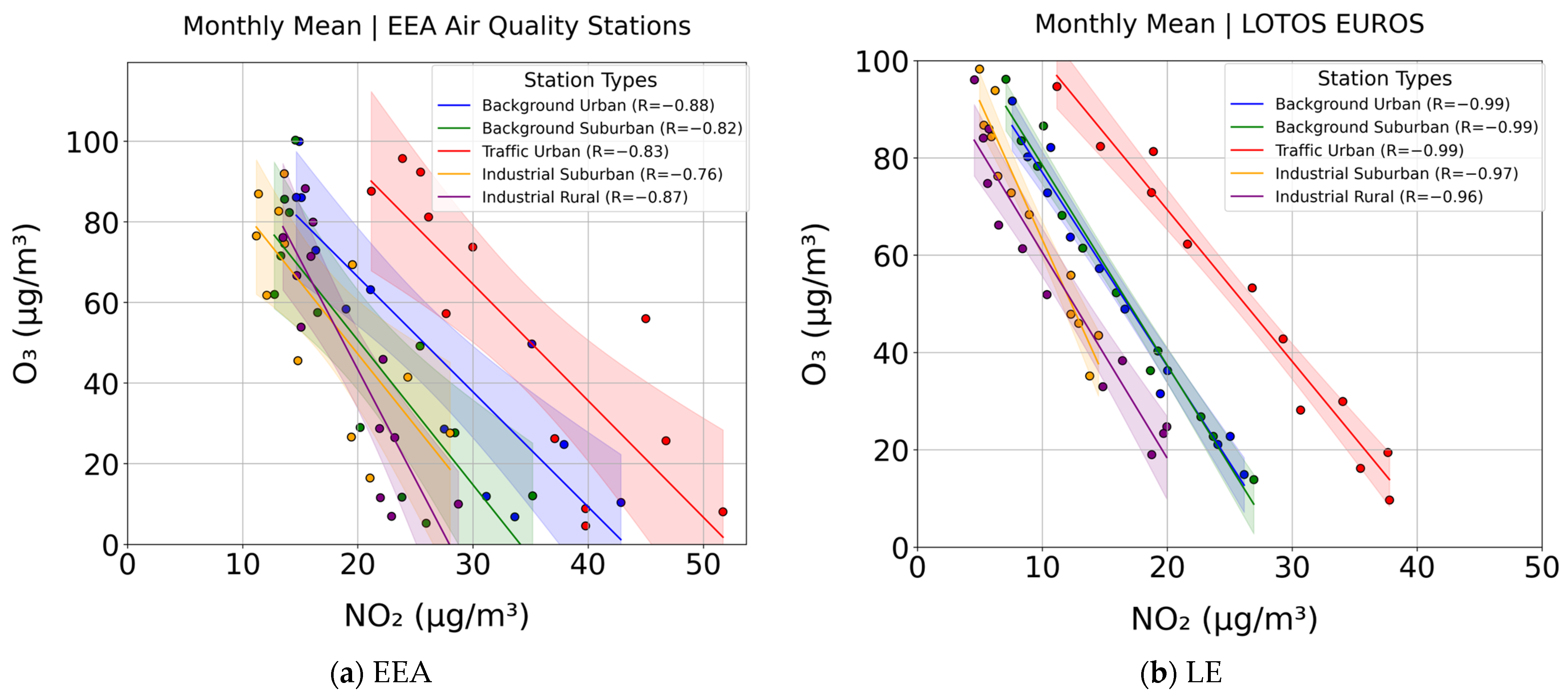

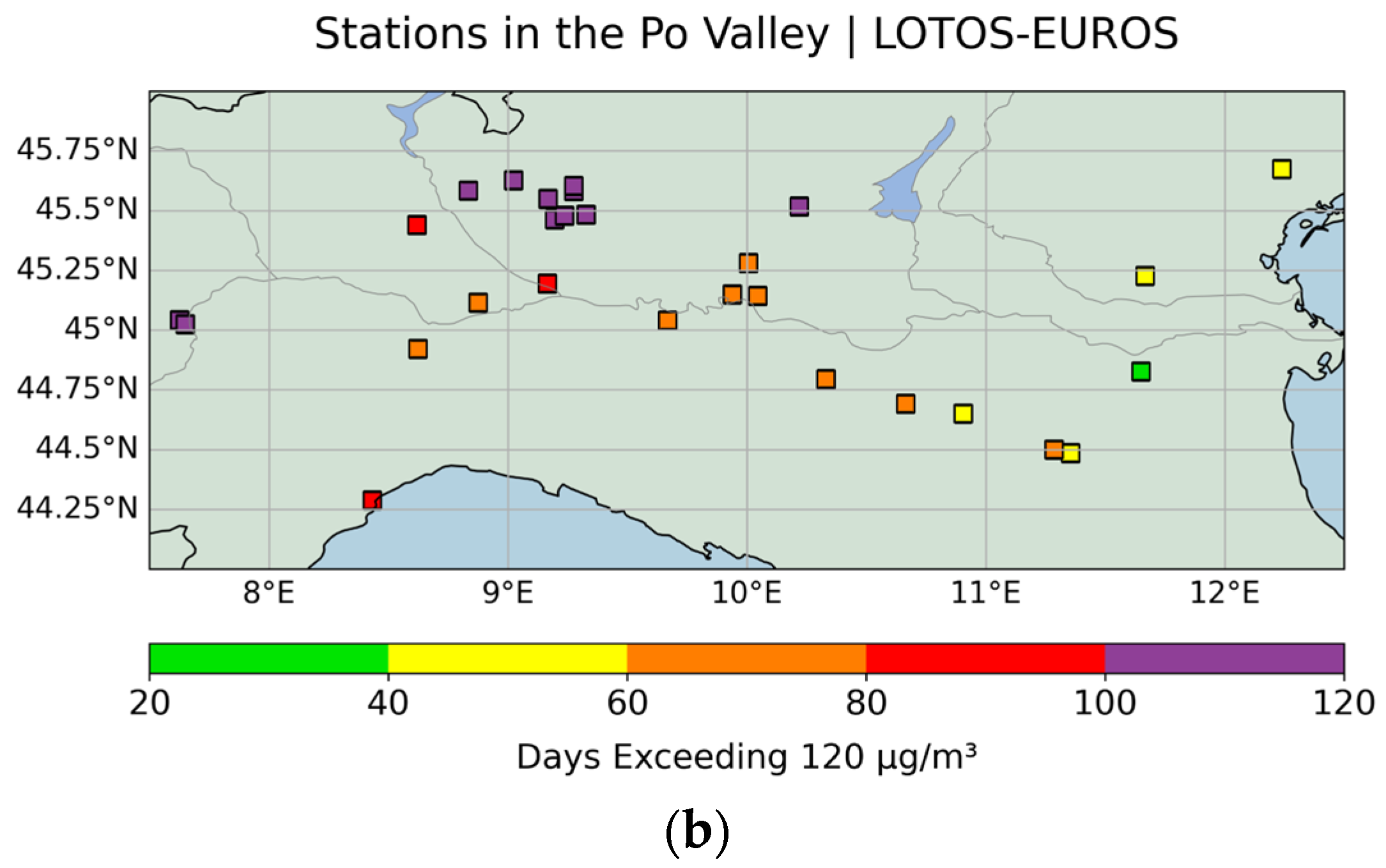
| Station Type | Annual O₃ | Monthly O3 | Annual NO2 | Monthly NO2 | ||
|---|---|---|---|---|---|---|
| (mean ± 1σ) | max | min | (mean ± 1σ) | max | min | |
| Background urban | 49.90 ± 32.82 | 99.94 | 6.82 | 25.76 ± 10.14 | 42.84 | 14.65 |
| Background suburban | 49.52 ± 32.12 | 100.27 | 5.27 | 20.31 ± 7.35 | 35.18 | 12.74 |
| Traffic urban | 51.46 ± 35.11 | 95.72 | 4.61 | 34.53 ± 10.13 | 51.71 | 21.16 |
| Industrial suburban | 58.47 ± 25.97 | 91.96 | 16.50 | 16.85 ± 5.52 | 28.01 | 11.19 |
| Industrial rural | 47.18 ± 29.64 | 88.28 | 6.93 | 19.30 ± 4.76 | 28.73 | 13.50 |
| R Value | ||||
|---|---|---|---|---|
| Station Type | Winter | Spring | Summer | Autumn |
| Background urban | 0.98 | 0.96 | 0.94 | 0.97 |
| Background suburban | 0.98 | 0.95 | 0.94 | 0.95 |
| Traffic urban | 0.93 | 0.87 | 0.83 | 0.87 |
| Industrial suburban | 0.93 | 0.95 | 0.98 | 0.97 |
| Industrial rural | 0.94 | 0.96 | 0.96 | 0.97 |
Disclaimer/Publisher’s Note: The statements, opinions and data contained in all publications are solely those of the individual author(s) and contributor(s) and not of MDPI and/or the editor(s). MDPI and/or the editor(s) disclaim responsibility for any injury to people or property resulting from any ideas, methods, instructions or products referred to in the content. |
© 2025 by the authors. Licensee MDPI, Basel, Switzerland. This article is an open access article distributed under the terms and conditions of the Creative Commons Attribution (CC BY) license (https://creativecommons.org/licenses/by/4.0/).
Share and Cite
Musollari, S.; Pseftogkas, A.; Koukouli, M.-E.; Manders, A.; Segers, A.; Garane, K.; Balis, D. The Spatiotemporal Variability of Ozone and Nitrogen Dioxide in the Po Valley Using In Situ Measurements and Model Simulations. Remote Sens. 2025, 17, 1794. https://doi.org/10.3390/rs17101794
Musollari S, Pseftogkas A, Koukouli M-E, Manders A, Segers A, Garane K, Balis D. The Spatiotemporal Variability of Ozone and Nitrogen Dioxide in the Po Valley Using In Situ Measurements and Model Simulations. Remote Sensing. 2025; 17(10):1794. https://doi.org/10.3390/rs17101794
Chicago/Turabian StyleMusollari, Stiliani, Andreas Pseftogkas, Maria-Elissavet Koukouli, Astrid Manders, Arjo Segers, Katerina Garane, and Dimitris Balis. 2025. "The Spatiotemporal Variability of Ozone and Nitrogen Dioxide in the Po Valley Using In Situ Measurements and Model Simulations" Remote Sensing 17, no. 10: 1794. https://doi.org/10.3390/rs17101794
APA StyleMusollari, S., Pseftogkas, A., Koukouli, M.-E., Manders, A., Segers, A., Garane, K., & Balis, D. (2025). The Spatiotemporal Variability of Ozone and Nitrogen Dioxide in the Po Valley Using In Situ Measurements and Model Simulations. Remote Sensing, 17(10), 1794. https://doi.org/10.3390/rs17101794







